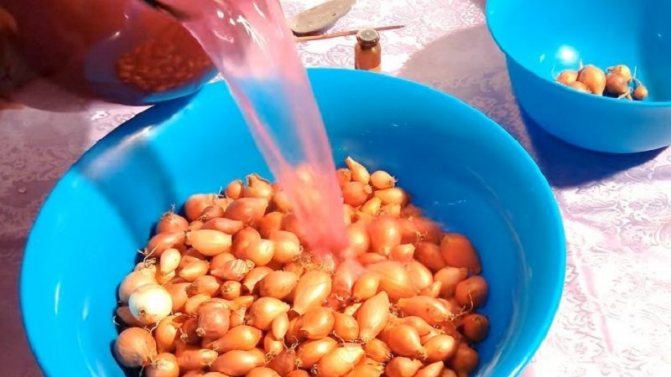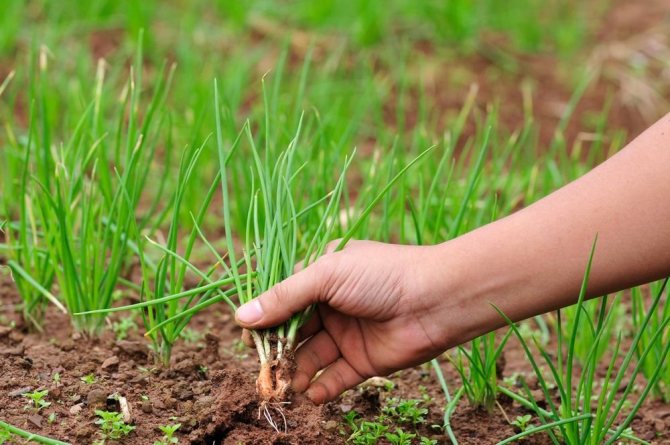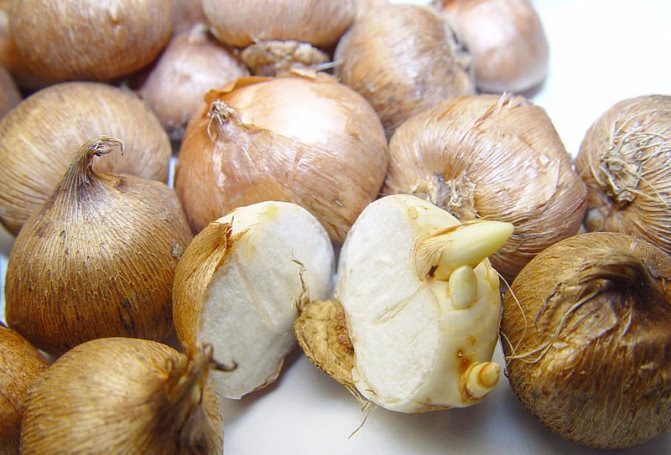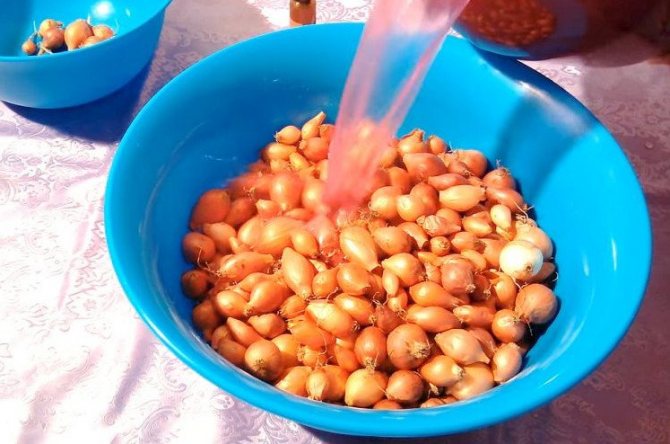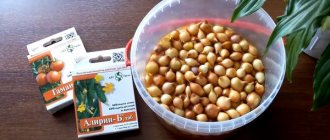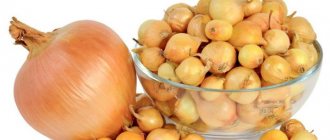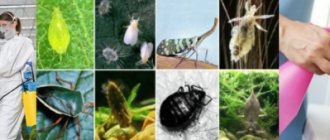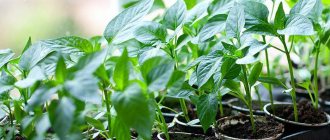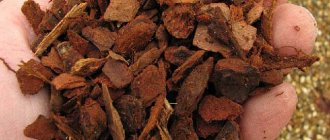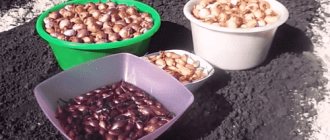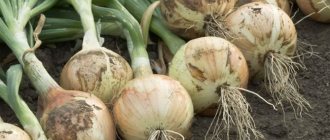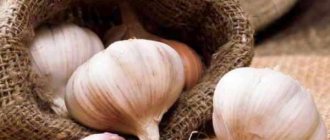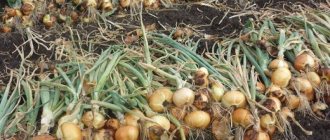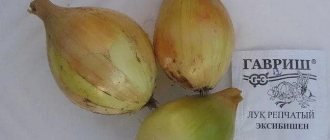
To obtain and increase a good harvest, gardeners are trying to find more and more useful information. Experts recommend soaking the onions before planting. The procedure is short-lived and does not require much knowledge and experience of the gardener, the main thing is to know which preparations are suitable for such manipulations.
Preparing the onion for planting
The first and rather important stage in the preparation of seedlings before planting is a careful selection of seeds. It is performed as follows:
- it is better to discard too soft and spoiled small onions immediately, since something good is unlikely to grow out of them. The same goes for completely dried seeds;
- if the bulb has not yet started feathering, it is advisable to "cut" it. For this purpose, carefully cut off the husk in order to significantly accelerate germination;
- dry the selected seeds in a warm and dry place;
- we carry out heating the onion.
It is recommended to do this in several stages. First, we keep the seeds at a temperature of at least 20 degrees for 2-3 weeks, and then we warm them up at 35-40 degrees for about 10 hours. Watch the time carefully so as not to overexpose the onions, otherwise it will be difficult to count on a good harvest.
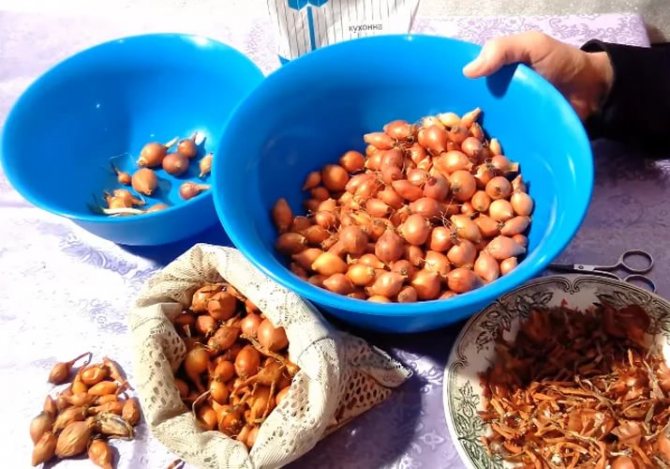

Alternatively, a different approach can be recommended as an alternative to such a long warm-up period. It involves soaking the seedlings in water with a temperature of up to 50 degrees for 10 minutes, then “bathing” it in cold water and a nutrient solution from fertilizers. This procedure generally takes about 6 hours and has almost the same effect.
Why pre-processing is needed
By purchasing seed materials in the spring, such as, for example, onion sets, you can really save yourself from the preparatory stage, to which farmers devote quite a lot of time. This is seed germination. Of course, this approach saves time and effort for the gardener, but does not guarantee the purity and sterility of the future product.
Sometimes it happens that a person acquires planting material, sends it to the soil, looks after it and hopes for a good harvest, but bad luck - the result is depressing:
- small onions;
- soft heads with noticeable traces of decay;
- low yield due to product loss.
Why is this happening? If you carefully read the sequence of actions performed by a person, you can understand that he simply missed the stage of disinfection of purchased products. Is it that important? Of course, because the features of the product are not known for certain, as are the methods of obtaining it and methods of storage.
It is beneficial for the seller to have time to sell the prepared material, and the more, the better. It is possible to argue with this statement, but it is useless. Yes, there are exceptions - people who think about the future and want to acquire a good customer base, but there are not many such implementers (about 10%).
It turns out that any product purchased in a store or on the market must undergo additional processing (salt, potassium permanganate). This approach allows you to remove not only surface contamination (dust, special reagents that preserve the excellent appearance of the leaves, etc.), but also destructive microorganisms that inhabit the seedling.
How to process onion sets
Onion processing is a mandatory preparatory step. It is performed just before landing and consists of the following procedures:
- immersion of onion seeds in a weak (2 tablespoons of salt in two liters of water) saline solution. Such treatment allows to ensure the rapid development of the plant, as well as its protection from any aggressive environmental influences, to disinfect the bulbs from the nematode. You can use both regular rock salt and sea salt, the effect will be the same. Dive time - approximately 2-3 hours;
- disinfection using potassium permanganate. Despite the emergence of many effective modern substances, this tool still remains the most popular and at the same time inexpensive. Processing before planting is carried out in this way: 35 grams of potassium permanganate is diluted in 10 liters of water, after which the seeds are immersed in the resulting solution. Two hours will be enough to provide protection against any plant diseases.


Instead of potassium permanganate, you can disinfect before planting with copper sulfate or Fitosporin using the same dosage.
Do I need to process before planting?


This question worries many gardeners. After all, the soaking process requires additional financial costs, as well as time and effort. Is it really necessary? When growing onions on an industrial scale, this step is usually dispensed with.
You can also not load yourself with additional preparation if you use high-quality planting material that grew on healthy soil and was stored under all conditions. If you are not sure of the quality of the set, it is better to soak it... Procedure:
- help get rid of pests;
- prevent the development and spread of diseases;
- prevents bulbs from rotting.
Also, in the process of soaking, the bulbs are fed with nutrients, which is important for the growth of the future crop.
Soaking is essential when preparing onion sets for winter stocks for planting. This procedure will further positively affect not only the size and quality of the bulbs, but also their keeping quality. That is, in winter they will be stored without spoiling for a long time.
Also it is recommended to soak the seedlings if the conditions for growth are unfavorable: for example, rather poor soil or dry period. In this case, additional preparation increases the bulbs' chances of survival and normal growth.
Preparing the soil for planting onions
Properly processed onion seeds can produce a good harvest. But for this you will need to choose the right place on the garden plot and properly prepare the soil before planting them. It is better to start this process in the fall. Remember that leek seeds germinate best in well-sunlit areas. They are also hygrophilous, but at the same time do not tolerate excessive amounts of moisture. Therefore, it is required to choose a place open to the sun's rays, where there is no groundwater at all, or they lie at great depths.
The selected area in the fall needs to be well dug up and fertilized into the soil (rotted manure or its mixture with peat is suitable). On acidic soils, it is better to perform liming, which will create optimal conditions for growing onions.
It is undesirable to apply fertilizer before planting, unless you are going to grow onions exclusively on a feather. In addition, such treatment will lead to rapid growth of weeds, and you will have to weed the beds all summer, getting rid of them. All that needs to be done in the spring is to loosen the soil a little, break the hard crust and start planting.
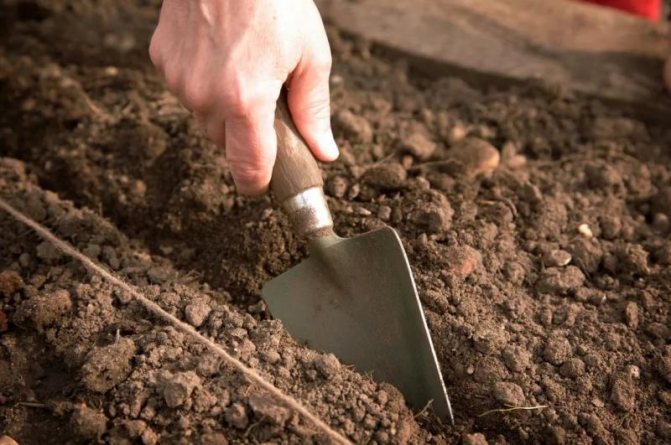

The plant grows well in areas where crops such as peas, cabbage, potatoes and tomatoes were previously cultivated.As an additional protection, onions can be planted in the immediate vicinity of carrots. Its phytoncides will be a powerful barrier to onion flies and will allow you to get an excellent harvest. When planting a seed, be sure to water it with a small amount of water, and also sprinkle it with sawdust - they will help prevent wet soil from sticking to the seeds.
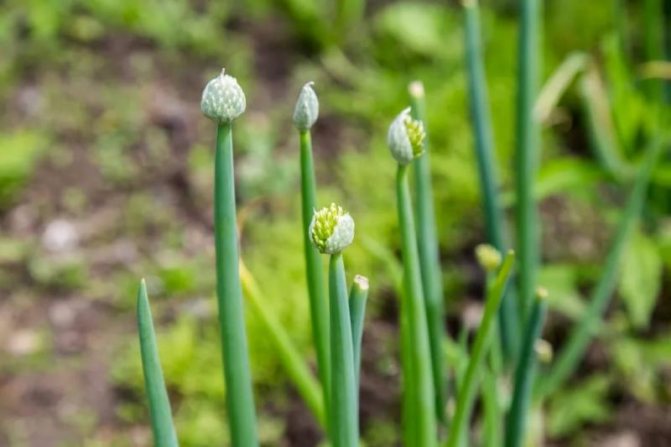

Landing features
Planting a culture before winter is carried out immediately after a stable decrease in air temperature to + 5 ° C is established. It is impossible to delay planting, since the planting will not have time to take root before the onset of frost. Sowings planted earlier than the recommended times can germinate before winter.
Soil preparation
For growing crops, areas with fertile, well-drained soil are chosen. Loamy, neutral soils are best suited. The site should be well lit by the sun and not be in a lowland, where there will be a constant stagnation of moisture.
The site is cleaned of plant residues and, 10 days after planting, it is deeply dug up with the introduction of humus (5 l / m²), superphosphate (30g / m²).
Winter onion planting technology
For planting onions, dry weather is chosen. On the site, grooves are made with a depth of 2.5-3 cm.A distance of 25-28 cm is left between the beds.When growing seedlings to obtain green mass, the bulbs are placed at a distance of 5-6 cm.
If it is necessary to grow a turnip, the distance is increased to 8-10 cm. The heads are placed vertically in the grooves, sprinkled with soil, tamping a little.
Attention! When planting crops before winter, the beds are not watered.
Care
Onions planted in autumn do not require watering, as the soil will not dry out during the rainy season. The beds are covered with a layer of mulch. During the winter, onion planting will remain dormant. Crop care is necessary with the onset of spring. In early spring, mulch is removed so that the beds begin to warm up with the sun.
When the topsoil dries up, watering is carried out. After them, the soil is loosened to improve aeration of the roots. Simultaneously with loosening, weeds are removed, taking nutrients from the soil. Onion shoots are thinned as necessary.
The first feeding with wood ash is carried out after removing the mulch from the beds. During the active growth of green mass, fertilizing with a solution of chicken manure is used. During the formation of turnips, urea (20 g / m²), superphosphate (30 g / m²) are added to the soil. The third top dressing is carried out by introducing potassium nitrate (20 g / m²) into the soil.
Watering is carried out once a week. When dry weather is established, the culture is watered every 3 days.
How to prepare a bow so that it does not go into the arrow
Preparing onions for planting includes several stages, each of which is very important:
- Sorting and quality control of the bulbs;
- Drying;
- Warming up;
- Soaking and disinfection;
- Rinsing and airing after disinfection.
Since planting this vegetable crop for gardeners is a serious and responsible business, you should dwell on the consideration of each stage of preparation in more detail.
At the very beginning, 3 weeks before planting, it is advisable to assess the quality of the material prepared for this. To do this, you need to carefully sort it out, examine it, and remove the diseased, dried and rotten onions.
Sorting and quality control of the bulbs
Then sort the bulbs by size. This is done in order to fit large heads first, because they germinate more slowly and are used more for cutting green feathers and growing for seeds. Medium-sized bulbs are planted second, small ones last. It is known that the smaller the bulbs, the faster they germinate and yield better yields in good soil.
Drying
At the next stage, the sorted onions must be thoroughly dried in a warm room, protected from drafts and moisture. This is usually done in attics.
At home, you can put onions on top of kitchen cabinets, or on top shelves.
Warming up
Then, the dried bulbs, in order to avoid early formation of arrows, must be well warmed up by sprinkling around the battery. On warm spring days, onions can be warmed up in warm sunlight.
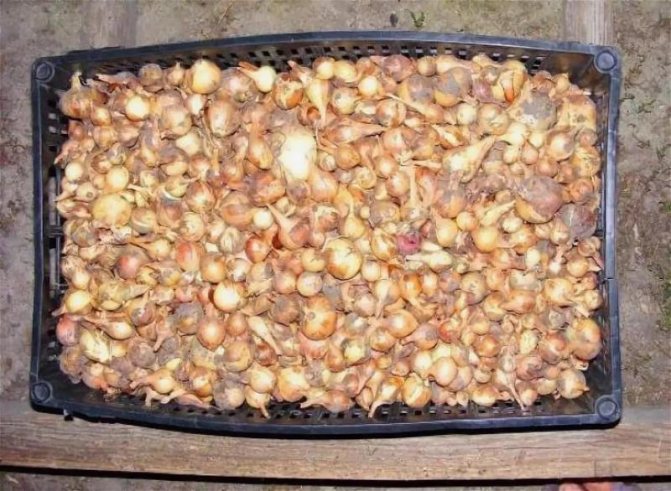

It is recommended to heat the onion for the first 15 days at a temperature not lower than plus 20 degrees, and then heat the onion for 8-10 hours at a temperature of up to 40 degrees. During the last warm-up, it is important to keep track of the time, not to overexpose or overheat the onion.
Soak
This is followed by the procedure for soaking and hardening the future harvest. To do this, the onions are soaked in water with a temperature of plus forty - plus fifty degrees for 15 minutes, and then soaked in cool water for the same amount of time. Then you can put the onion in a solution of mineral fertilizer for 5-6 hours.
Treatment against pests and diseases
But the most important goal of the process of soaking onion sets before planting is, of course, disinfection, destruction of pests and prevention of diseases during the growth of the crop.
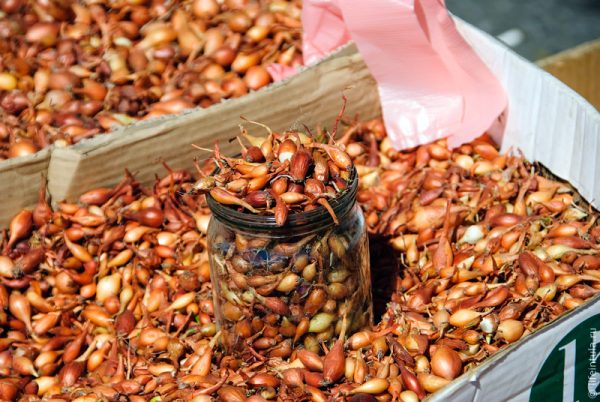

You can disinfect onions in this way:
- soak for 2-3 hours in a weak salt solution prepared at the rate of 2 tablespoons per 2 liters of water;
- soak for about two hours in a dark solution of potassium permanganate.
After each soaking, the bulbs should be rinsed in clean water.
Also, the old proven and effective method is very well suited for disinfection - soaking in a solution of copper sulfate prepared at the rate of 30 grams per 10 liters of water. The bulbs should be soaked in this solution for about two hours and then rinsed with water.
Soaking onion sets in a saline solution of salt is detrimental to pests such as onion flies, thrips and ticks. A solution of potassium permanganate perfectly destroys fungal spores, thereby preventing fungal infection of the bulbs.
Instead of potassium permanganate for disinfection of bulbs, other chemical agents presented in garden shops (copper oxychloride, etc.) are also widely used.
Often, to stimulate root growth, the bulbs are soaked in various growth stimulating solutions. More common here are solutions of humate and zircon.
At the end of the soaking and disinfection stage, the onions must be washed, dried and ventilated. Only then can you start planting it.
Onions are usually planted in the soil after waiting for the ground to warm up to plus 15 degrees. But it is also not recommended to tighten the onion planting.
Preparations for soaking onions
In addition to folk recipes for soaking onions before planting, ready-made compositions are also used. The following stimulants can be purchased for treatment:
- "Maxim"
... Sold in liquid form in ampoules. The active ingredient is fludioxonil. It is used to prevent the appearance of mold, root rot and many other problems. - "Epin Extra"
... A biostimulating drug that helps to increase the immunity of the plant, accelerate ripening and at the same time significantly increase the yield. Soaking the onions before planting will help solve many problems later on. - "Energen"
... Growth stimulant with a wide range of actions. The composition contains the following main substances: humic and fulvic acid. Additional substances include sulfur and silicic acid. - "Humat +7"
... A highly effective fertilizer. The main action is to stimulate the active growth of all plant species. In addition to nutritious humus, the composition contains a large number of different nutrients, which, when soaked onions before planting, will bring a lot of benefits. - "Biostim"
... Organomineral fertilizer based on amino acids of plant origin.The composition is completely natural. It is a long-used tool that is not inferior to new developments. - "Zircon"
... An immunomodulator that helps not only to restore protective functions, but also stimulates the rapid development and growth of onions. The chemical composition is rich in many beneficial substances and minerals. In addition, various acids are present there.


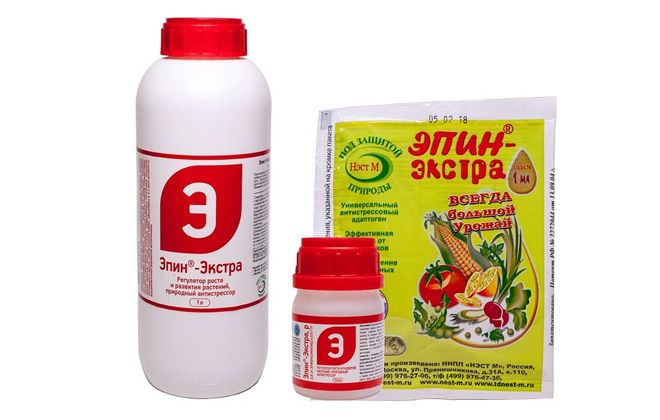

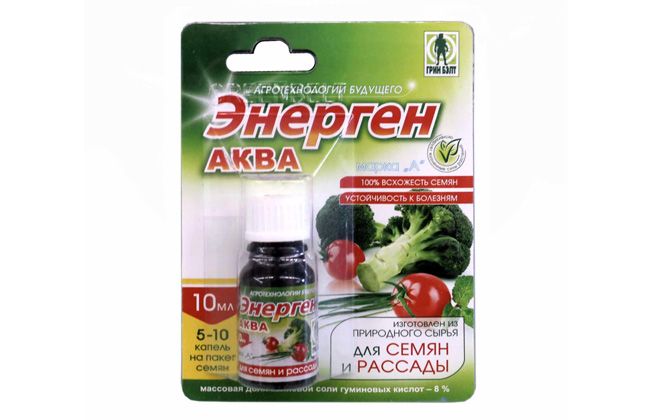

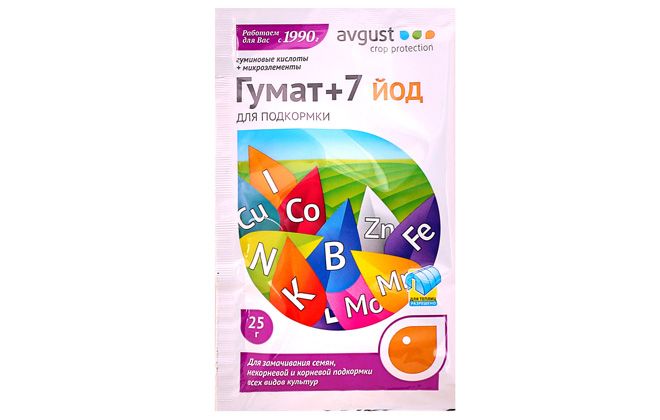

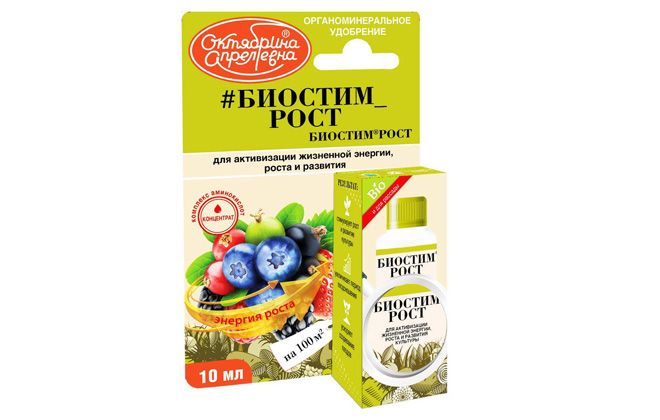

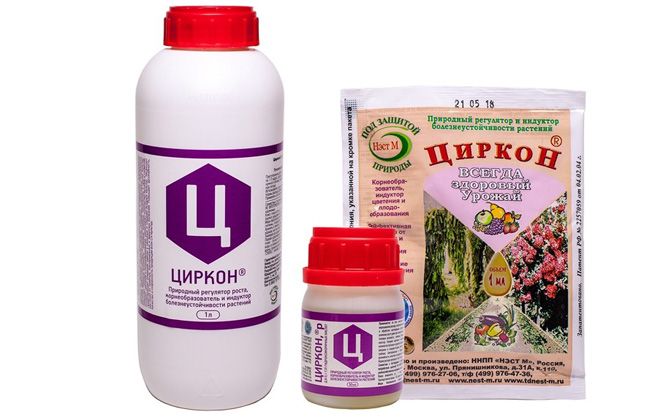

Such preparation of onions for planting in spring will help improve germination, grow roots faster and, in addition, strengthen resistance to adverse conditions. The drug is dissolved in water, strictly following the instructions on the package. The water should be heated up to + 40 ° C. The onions are placed in the composition for a maximum of 15 minutes. Drying is mandatory before planting.
Selection of planting material, preparation
It must be remembered that conscientious and painstaking observance of all the rules for preparing onion sets for planting will ensure its abundant and rapid growth, and as a result will delight gardeners with a rich and high-quality harvest!
Processing and soaking onions before planting
First of all, when preparing the set for planting, you need to carefully sort it out. Equip yourself with multiple sorting containers.
It is necessary to discard all damaged and small specimens, leaving medium-sized onions for planting on the head. Large bulbs, small and even sprouted ones, are suitable for greens. But empty, wrinkled, missing - we throw it away.
Next, carefully cut off each dry tail at the crown with scissors. This simple operation will help them germinate faster and better. Well, you need to be afraid that an infection will get into the cut, because the sevok will be treated from diseases before planting.
Should onions soak before planting? And what is the best way to do it? Let's figure it out.
Of course, we are interested in our sevok growing large and at the same time being protected from diseases and parasites. Therefore, a simple scheme is usually used: first, the planting material is soaked in growth stimulants, and a little later, just before planting, it is treated with protective agents.
To feed the bulb so that it grows large, it is recommended to dilute the complex fertilizer in water (40-45 degrees) and soak the onion there overnight. When the sevok is saturated with usefulness, you can proceed to its protective processing and planting.
Most popular recipes:
- Soaking onions in potassium permanganate. We make a strong dark pink solution of potassium permanganate and soak the bulbs in it for 2-3 hours. After that, they will need to be rinsed under running water so that the concentrated potassium permanganate does not damage future young roots. Potassium permanganate prevents fungal and bacterial diseases.
- Soaking onions in saline. 1 tbsp. Dissolve 1 liter of salt in one liter of water, immerse the bulbs in it for 2-3 hours. Salt also prevents rotting and disease.
- Soaking in copper sulphate. 1 tsp of copper sulfate in 10 liters of water, for 10-15 minutes. Copper sulfate disinfects seedlings and protects them from diseases.
These are the time-tested ways to prepare onions. But time does not stand still, and we want to share with you new interesting recipes that will help to comprehensively protect plantings. One of these recipes is a combined treatment with salt, potassium permanganate and ash together, in one solution. How to do it, see below:
Processing onions before planting with salt, potassium permanganate and ash
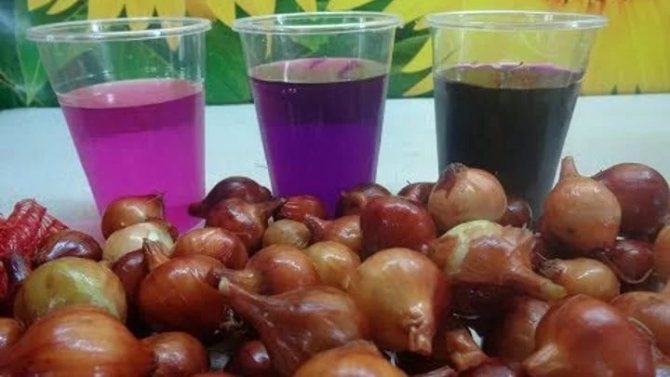

For a three-liter jar of warm (60 degrees) water we take 2 tbsp. l with a slide of salt dark pink solution of potassium permanganate 2 tbsp. l of wood ash. Soak for 2 hours.


Treatment of onions before planting from pests with birch tar
The most nasty onion pest is, of course, the onion fly. Fortunately for us, she cannot stand the smell of birch tar. And if you want to protect your crops, then it would be useful to soak the onion in a solution as well: 1 tbsp. l. tar in a liter of water for 10-15 minutes.
With the same solution, you can additionally spill plantings during the growing season.
Why do you need sevka processing?
Although onions are quite unpretentious to grow, it is necessary to carefully prepare the sets for planting in the spring. The quality of the planting material is difficult to determine by eye, especially if the bulbs are small. Therefore, before planting onions, the planting material is prepared, including soaking.
Pre-sowing prophylaxis will help separate a good crop from a bad one and improve the quality of the crop:
- Accelerate the maturation of the heads and the emergence of greens. The presence of the bulbs in the water, even for a short time, stimulates the germination of the roots - this significantly increases the emergence rate of onion feathers. In addition, saturating the seedlings with water helps to increase yields.
- Prevent arrowing. Bulbs that are soaked in hot water are exposed to temperature stress, which leads to the production of substances that block kidney formation and onion shooting.
- Disinfect the bulbs. Soaking in solutions disinfects the seedlings, destroys pest larvae and prevents rotting and disease. If bulbous crops are planted annually in one place, there is a high probability of contamination of crops with bulbous flies or bacterial diseases, in which case soaking is necessary.
What are the pros and cons of the procedure?
Until now, among gardeners, disputes do not subside about whether it is necessary to soak onion seeds or not. Of course, this is everyone's business, and before making a decision, you need to familiarize yourself with the pros and cons of soaking onions.
Pros:
- Abundant growth of both greenery and turnips.
- Disinfection.
- Prevention of decay.
- Protecting the soil from pathogenic bacteria that can be carried along with the seeds.
Minuses:
- Before soaking, you need to cut the onion, and if the seeds are too small, it will be a rather laborious task.
- Incorrect preparation for soaking and violation of the temperature regime.
- Seeds can deteriorate due to improper cutting or non-compliance with the proportions of the solution (read how to properly cut the onion here).
Methods for processing onions before planting
Regardless of where the set was purchased, it is imperative to process and soak the onion before planting.
Preparation takes place in several stages:
- Sorting
- Hardening
- Warming up
- Soaking and processing.
In order to properly process the planting material, preparatory activities must be started no later than three weeks before planting.
Sorting
At the first stage, high-quality planting material is selected. Dried, decaying or damaged bulbs are not allowed for cultivation, they must be disposed of.
It is important to remember that how quickly the culture germinates depends on the size of the bulbs, therefore, when sorting, they select:
- large onions - they are planted first;
- middle - second;
- small - the last.
Hardening
Hardened bulbs have strong immunity and are less susceptible to pests. They also keep better. Sevka hardening is carried out at the beginning of spring.
After sorting, the seedlings are put into a box and placed in a room with a temperature of 0 to 8 degrees - this can be a cellar or a refrigerator. Hardening lasts up to ten days, then the bulbs are removed to a warm place.


If there is no time for normal hardening, you can carry out express hardening just before planting. After soaking, the bulbs are rinsed with cold water, dried and warmed up in the sun.
The sorted bulbs are warmed up before planting to “wake up” the bulbs and prevent shooting. The procedure can be skipped if the set was stored at home at a temperature of at least 18 ° C, but purchased bulbs are always warmed up - it is not known in what conditions they were kept.
Sevok is warmed up three to four days before planting. To do this, it is placed in a box or box next to a heat source and covered with a cotton cloth so as not to dry out. Onions need to be heated from ten hours to several days at a temperature of 35 to 40 degrees.
Salt treatment
This processing method is the simplest, therefore it is used most often. For ten liters of warm water, take five to six tablespoons of coarse rock salt or four tablespoons of fine iodized salt. The set should be soaked for five hours. After disinfection, rinse with warm water.
Salting will protect the onions from ticks, nematodes and other parasites. A less concentrated solution (two tablespoons per ten liters of water) is used to treat the garden bed before planting onions, but you should not carry out such a procedure too often - this will harm the fertile soil layer.
Potassium permanganate treatment
Another popular way of processing bulbs before planting is soaking in a solution of potassium permanganate.
Depending on the case, a solution of varying degrees of concentration is used:
A weak solution is prepared in a ratio of 35 grams of potassium permanganate per ten liters of warm water. Soak the heads for up to three hours.
A solution of medium concentration is used if the seed is infected with fungus or mold. For effective prevention, ten grams of potassium permanganate per liter of water is used, the bulbs are soaked for 40-50 minutes. A highly concentrated solution is used to kill powdery mildew or onion fly larvae. In a liter of water, you need to dissolve 25 grams of potassium permanganate, soak the set for 15-20 minutes. After this method of soaking, the bulbs may darken.
Copper sulfate treatment
This method is very effective for disinfecting onions, but you need to work with copper sulfate with care - it is a poisonous substance, so use protective gloves when processing. It is necessary to prepare a solution in the ratio of 30 grams of copper sulfate per ten liters of water and soak the set for half an hour.
After processing, rinse the onion with cold water, dry it before planting.


Antiseptic treatment
Another remedy for processing onions before spring planting is Fitosporin-M, a special preparation based on a spore culture, which can be purchased at any specialized store. Antiseptic to water ratio: 35 grams per ten liters. Soaking time of bulbs: 30 minutes. There is no need to rinse after the procedure.
Fitosporin will protect future crops from fungi and bacterial diseases.
Treatment of seedlings with growth stimulants
To accelerate growth in spring planting, special growth stimulants are used:
Biostim activates the natural metabolic processes of the plant. The drug is diluted in accordance with the instructions, the bulbs must be warmed up in hot water before processing. Epin-Extra accelerates the development of the root system. Dissolve two capsules in ten liters of water, soak the set for fifteen minutes.
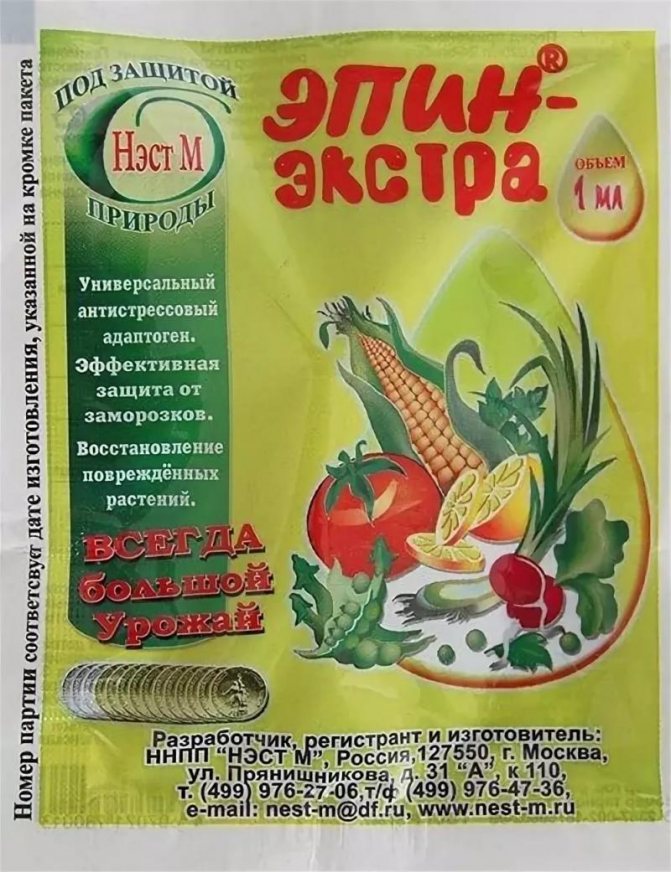

Wood ash accelerates growth and protects the plant from rotting. In a solution of 500 grams of ash per ten liters of water, soak the bulbs for ten minutes, then dry for three hours.
The benefits and harms of potassium permanganate for plants
Since experienced gardeners argue that "processing onions before planting with a weak solution of potassium permanganate is a key stage on the way to a quality product", then this statement must be substantiated.
The benefits of potassium permanganate for plants:
- Protection of seeds from wintering pests, due to the revealed antiseptic effect (if they are soaked in a specially prepared solution).
- Potassium permanganate is a kind of unique foliar fertilizer. The thing is that feeding with manganese allows you to deliver to plants the minerals that are so necessary for full growth and development.
- The defeat of fungi and their spores (antifungal properties of potassium permanganate). Thanks to the correct action, it is possible to save not only onions, but also strawberries from gray rot, and tomatoes from late blight.
However, there is no need to rush to water all the beds with a solution of potassium permanganate, because this is a chemical compound that can harm the human body (provoke burns of mucous membranes and skin, provoke diseases of the skeletal system), reduce soil productivity, etc.
Important: potassium permanganate can be used to irrigate soils with alkaline or neutral acidity. If you neglect this advice, then you can reduce fertility and lose crops (of course, for some varieties of plants, an acidic environment is useful, but not for everyone).
How do you make it so that you get beautiful bulbs that can please the eye throughout the whole year? The answer is simple: "Study the peculiarities of using potassium permanganate (how to properly prepare the composition, water the plants, soak root crops, etc.)"
The main problems when growing onions
Some gardeners consider it normal to plant seedlings in a dry way, without any preparation. But this can only be done with perfectly healthy planting material that has been properly stored. Otherwise, the summer resident risks getting the following problems:
- fungal and bacterial diseases;
- damage to plantings by pests;
- archery.
Avoiding most of them will help the correct preparation of the seed before planting.
First of all, the seedlings are carefully examined, sorted by size and bulbs with spots and traces of disease, soft and sprouted are discarded.
Secondly, the tips of the integumentary scales should be cut off without affecting the growth point. Pruning will allow the onions to germinate faster, but this is best done after soaking, when the top scales are soaked and easier to clean.
How to prevent shooting
The appearance of arrows on onion beds is a consequence of improper storage of planting material in the winter. So that the planted seed does not go into the arrow, it is necessary to observe the temperature, humidity and their ratios during storage in the room. If the conditions are not met, the bow begins to throw arrows.
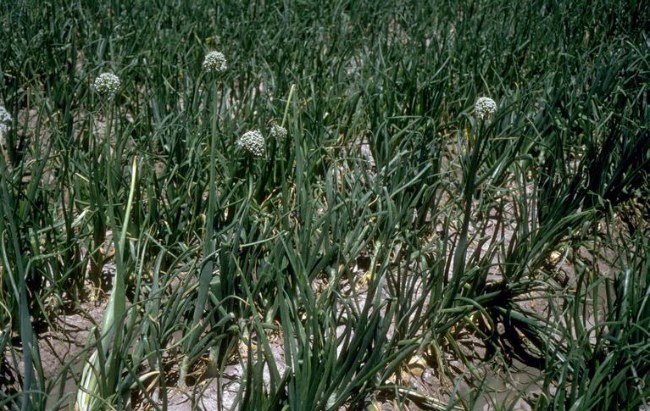

If the set was purchased in a store, it is recommended to warm it up before planting. This is done in two ways:
- Warming up at a temperature of about 30 ° C for a week. The set is poured onto a wooden tray with a layer of not 2-3 cm and put on the battery;
- Immediately before planting, the onion is poured with very hot water (60–65 ° C), soaked for 2 minutes, the water is drained and the procedure is repeated in cold water.
Heating reduces the ability of the set to release arrows. Single copies are shot even after warming up. Then the arrows break out as soon as they become noticeable.
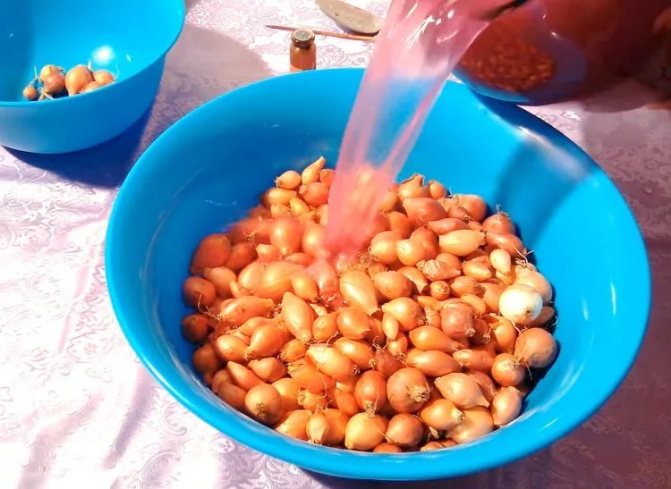

Prevention of fungal diseases
For disinfection, the planting material is soaked in disinfectant solutions. To do this, use:
- Salt. A tablespoon of salt is stirred in 1 liter of warm water. The onion sets are immersed for 2-3 hours, after which they are washed several times in clean water.
- Potassium permanganate. In a strong solution (3 g or half a teaspoon / 3 l of water), the seedlings are soaked for 2–2.5 hours, then rinsed thoroughly with clean water.
- Baking soda. Dissolve 1 teaspoon in 1 liter of warm water and lower the set for 2 hours.
- Fitosporin. The drug is diluted according to the instructions and the sevok is soaked in it for the prescribed time. After treatment with Fitosporin, onions are not washed.
- Copper sulfate. 50 g of the drug is diluted in a small amount of hot water, then poured into a 10 liter bucket. The onions are disinfected for half an hour, then washed and dried.
It is not necessary to use all the tools at once. Folk remedies and biopreparation Fitosporin are good only for prevention. Copper sulfate is considered more effective and is used in cases where in past years onion plantings have suffered greatly from fungal diseases.
However, keep in mind that for prevention, you need to carry out a set of measures, including following the rules of crop rotation and cultivating the land from fungal spores.
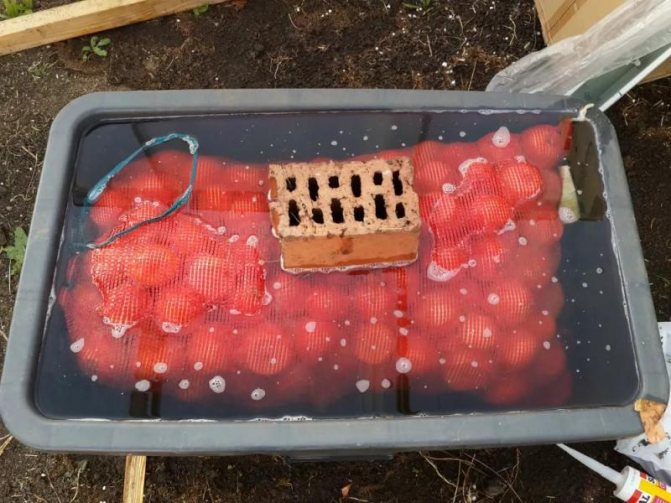

Processing of seedlings in biostimulants
Such procedures are not necessary, but they will help to get strong plants with high immunity, and, as a result, a good harvest. To stimulate growth, the seedlings are soaked in the following preparations:
- Epin-Extra. The biostimulant increases the immunity of plants, increases productivity and accelerates the formation of root crops. It is necessary to use the drug according to the instructions. Complex mineral fertilizer has similar properties. 1 tablespoon of fertilizer is diluted in a bucket of water and the seed is soaked for a day.
- Ash. A half-liter jar of sifted wood ash is dissolved in a bucket of water, the planting material is infused and soaked in this solution for 2-3 hours. Ash is considered an excellent antiseptic and contains a lot of essential trace elements.
Diseases and pests under favorable conditions can destroy a significant part of the crop. In addition, the causative agents of diseases persist in the soil and on plant debris.
This will make it difficult to grow vegetables in the following seasons. In order to prevent the development of diseases, it is necessary to prepare the onions selected for planting. These simple measures will help you get a high yield of healthy bulbs without the use of chemicals for treating plantations from diseases.
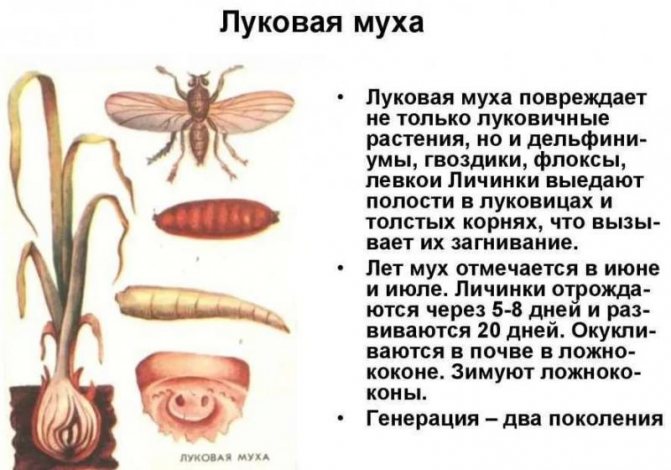

Onion fly: how to deal with it?
Before planting, the seedlings need to be soaked to ensure a healthy harvest. Thus, the onion is processed before planting from the onion fly. Traditionally, onion sets for disinfection are recommended to be soaked for a couple of hours before planting in a saturated solution of potassium permanganate, saline or Fitosporin. But against the hero of our article, this does not help much.
Experienced gardeners recommend doing this: put the prepared (trimmed) set in a warm mixture of water and tar (1 liter - 1 spoon) and stand for 2-3 hours. Since tar mixes very poorly with water, floating on the surface in spots, the sowing in the container is stirred from time to time. Better to cook onions outside - the smell is still the same. The resulting bulbs will not cause the pests to appetite, and the plantings will be safe.
How to get rid of an onion fly
Let us recall when it is most effective to fight this pest: the first time - at the end of April (when dandelion, lilac, cherry blossoms), the second time - at the end of July.


Onion fly: how to fight folk remedies
Joint landings
Again, we use the onion fly's susceptibility to certain odors. If you plant savory, carrots, celery, tomatoes, medicinal chamomile near the onion, this insect will most likely fly past your garden.
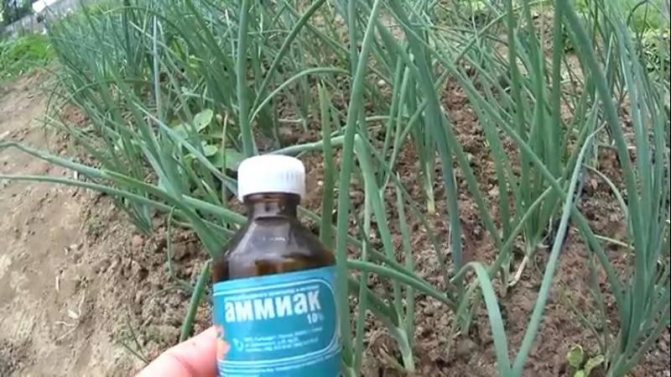

Onion fly ammonia
We have already written about the wonderful properties of ammonia, it is also ammonia. This substance contains nitrogenous compounds that are easily assimilated by plants, therefore, ammonia is recommended to be used for onions also as a fertilizer for yellowed tips and a "tired" look. That is, we kill two birds with one stone! Concentration - 10-20 grams per bucket of water, about a glass per plant. Watering is best done on damp ground.
Previously, gardeners clearly knew how to process an onion fly - with a saline solution.
Thoroughly spilled the soil in the garden, then watered the plants with saline, and watered again with clean water. After two weeks, the onion fly treatment was repeated with a stronger solution, after another three weeks - with an even stronger solution (one, one and a half, two glasses of salt are added to ten liters of water, respectively). This is a really effective way, but do you want to add that much salt to your soil? You decide.
Against onion flies, sprinkling the beds with dusty and smelling substances is also good: ash, tobacco dust, tabazol (a mixture of tobacco dust and sunflower ash), ground pepper, naphthalene, ground wormwood (you can mix, you can in pure form). After sprinkling, it is recommended to loosen the soil.
Infusions of strong-smelling herbs
It can be an infusion of dandelion, tobacco, tomato tops, wild rosemary, mint, fir, valerian, conifers.
If you want to fight the onion fly without adding anything to the garden, you can set pegs around the planting and pull a long cloth moistened with kerosene over them.
Video: Protecting onions from onion flies and diseases in one tool. How to prepare onion sets for planting
Onion fly: how to fight with drugs
Since this insect is quite well corroded (if not missed) by folk remedies, then in households you can not resort to chemicals. This is an option for farms and people who grow vegetables for sale. However, such drugs exist:
- "Mukhoed", "Medvetoks", "Zemlin" - the soil is cultivated when planting seedlings
- "Sochva Zh", "Aktara" - spraying onions
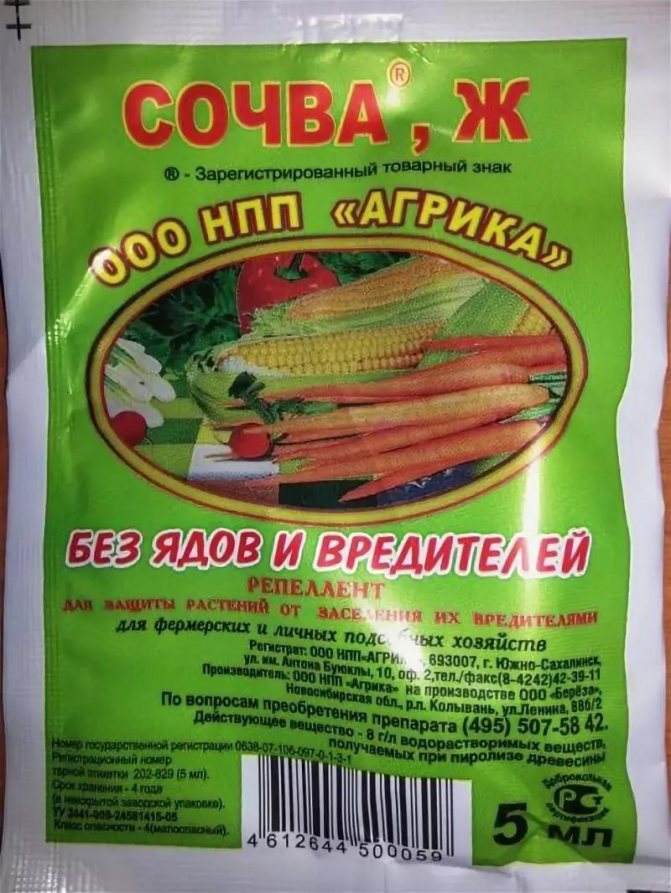

Fighting the onion fly, a couple more tips:
- observe the crop rotation: onions should settle in the same place with an interval of at least three years;
- dig up the ground after harvesting to a depth of at least 20 cm. This will bring the larvae to the surface, they will not have time to pupate and die;
- safe neighborhood between onion beds - at least 400 meters. That is, if your land is clean and there are no larvae in it, this does not mean that the neighbor's onion fly will not come and "throw" eggs at you. Therefore - prevention and prevention again!
This is how it is, an onion fly. The fight against such a common enemy must be proactive, because in a very short period the larvae can destroy the crop and make it unsuitable for storage. And since the choice of effective folk remedies is quite wide, the main thing here is not to be lazy and not to forget.
Have a nice harvest!
Useful Tips
When processing onions before planting with salt and potassium permanganate, it is worth taking into account the advice of experienced gardeners. They are as follows:
- Soak the seed or seed just before planting to increase their chances of germinating well.
- Particularly carefully approach the pre-sowing processing of onions in regions that are characterized by frequent rains and, as a result, dampness. In such conditions, the likelihood of contamination of the onion planting significantly increases, so the onion needs processing that stimulates the production of immunity.
- When preparing solutions, strictly observe the dosage of the active substance, otherwise its excess will harm not only the pathogenic microflora, but also the planting material itself, therefore it will not be able to ascend - the ovaries of the root system can "burn out" without even forming.
- To prevent the sevok from rotting, it cannot be kept in the prepared solution for too long. Soaking time in any solution is no more than 2-3 hours. When combining procedures, the time spent on them should not exceed 2 hours. Of these, about 1.5 hours can be allocated to the saline solution, and 30 minutes to the manganese solution.
- Soak the bulbs immediately before planting in the prepared heated soil. If they are disinfected and then left for a few more days in ordinary water, they will be immersed in the bacterial environment for the second time.
- Prepare a soaking solution just before processing so that bacteria that are dangerous to onions do not grow in it.
- It is necessary to soak the planting material before spring planting. Moisture-saturated seedlings in a heated soil will quickly harden and begin to grow.
- If you plan to plant onions before winter, it is undesirable to carry out such processing. The fact is that the sowing soaked in moisture will plunge into the ground (approximately in September - October), which will not be warmed up every day, but, on the contrary, will freeze. For this reason, it can rot or freeze, which will leave a negative imprint on the yield of the plant.
- The previous rule may not be relevant for the southern regions, where the soil remains warm for a long time even in autumn. However, winters here are not distinguished by heavy snowfalls, so you need to organize in advance a high-quality insulation of the garden for the winter season.
- Presowing treatment effectively fights bacteria and viruses, but even after soaking, not all harmful microorganisms will be destroyed. Those pathogens that have already penetrated the seeds or seedlings can survive. In this regard, it is required to observe preventive measures to protect onions from diseases and pests.
Harvesting and storage
Already in the middle of summer (July), winter onions can be harvested. The vegetable itself will signal when it needs to be dug up. Signs that it is fully ripe will be yellow leaves that will fall to the ground, and dry husks appearing on top of the fruit. The ripe bulb is easily removed from the soil. Watering the beds with onions should be stopped 2-3 weeks before harvesting.
Dig up onions in dry, sunny weather. You should not overexpose the vegetable in the ground, as it will start to take root and will be poorly stored. Harvesting can be carried out as the onions ripen, since not all onions ripen at the same time.
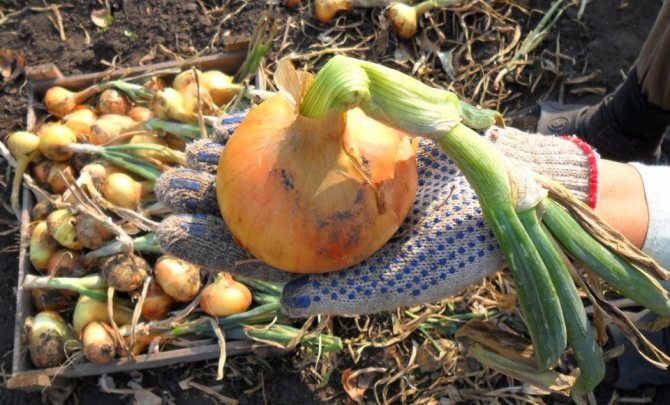

Before storage, vegetables must be thoroughly dried.
To do this, you need to carry out the following activities:
- after digging, leave the onion in the garden for 1-2 days for drying (do not peel the vegetables from the soil by tapping on a hard surface - this can damage them);
- in rainy weather, the onions are dried in the attic, under a shed or in another place that is well ventilated and protected from rain;
- during the drying period, the head of the vegetable must be turned over;
- the neck of the onion head will tell you that the onion is dry - it will be dry, and the husk will peel off a little;
- slightly rotted or damaged specimens should be set aside for consumption.
Dry and whole specimens selected for storage can be stored as follows:
- Cut off the neck and place the heads in nylon nets or tights, and then hang in a dry, dark place (basement, cellar, subfield).
- Place onions in wooden or plastic boxes. Shake the boxes from time to time to ensure an even flow of air.
- The necks can not be cut off, but braided with braids and hung in the basement. When stored in this form, the heads starting to sprout will be immediately visible.
The optimum temperature for storage is in the range of 0 ... + 3 ° C, and the humidity should be no higher than 80%. Onions should not be stored in polyethylene bags, as this can cause rotting due to lack of air intake.
We advise you to read why the onion rots from the inside and how to prevent it.
Salt
How to soak onions before planting? Despite the availability of a huge number of modern drugs, farmers choose the old proven methods. The saline solution contains substances that roundworms and fungal diseases do not like. The tool is used to treat both the seed and the garden bed before planting.
For preparation, dissolve 25 g of raw materials in 2 liters of warm water. It is important that there are no lumps and sediment left, so mix thoroughly with a wooden stick. You can dilute the drug in advance in a liquid, and only then dilute it in the main one.
It is best to use a large sieve or mesh. You can find alternatives like a paper bag or string bag. The main thing is that the turnips remain inside, and the liquid can get to them from the outside.
Soaking the onions in a saline solution before planting takes place for 3 or 4 hours. To facilitate the procedure, experienced farmers collect sevok in women's stockings. After processing, the "bags" are taken out and the turnips are laid out for drying. After 2-3 days, you can start work.
Difference between soaking a crop for greens and bulbs
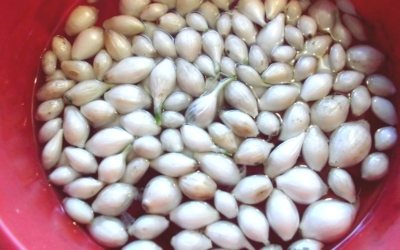

There are some differences in the process of steeping onions for greens and for heads.
Presowing processing of onions for greens is aimed at protecting against pests that affect the green mass. It is recommended to use:
- copper sulfate;
- potassium permanganate;
- saline solution.
It is equally important to stimulate the growth of green mass. For this, the bulbs are soaked in a solution with mineral fertilizers.Any composition intended for vegetable crops will do.
Advice
When growing onions for heads, the use of mineral fertilizers is inappropriate - they only stimulate feather growth. One of the tasks in this case is to prevent the formation of arrows. This can be achieved by heating.
Manganese
How to soak onions properly before planting? Safe home remedies are not always effective, so gardeners combine several methods. An additional procedure will disinfect the seed from infections, fungi and parasites. And the low cost of raw materials makes it possible to save the family budget.
Like salt water, potassium permanganate solution is used a couple of days before agricultural work. Soak the onion sets in a properly prepared liquid before planting. To do this, take 35 grams of crystals and dilute in ten liters of warm moisture. Mix thoroughly with a stick to dissolve the rest of the substance.
The sorted seedlings are placed in a stocking, and then carefully immersed in a container with a substance. After the specified time, the material is taken out and dried. After two days, you can start planting seeds.
Degtem
How to soak onions before planting? Birch substance will become an environmentally friendly alternative. It perfectly protects the turnip from diseases and insects. The procedure is carried out after careful preparation and rejection of the material.
A tablespoon of tar is dissolved in 1 liter of cold water. It is necessary to hold the raw material in this liquid for 2 hours. During this time, the active substance penetrates under the scales of the bulbs, creating a reliable film from fungi and flies.
The intense aroma of tar is unpleasant for insects, therefore it is recommended to water the beds in the spring before planting. Add one spoonful of the substance to a standard watering can. In a rainy summer, it is advised to re-irrigate under the root and greenery.
Optimal planting dates before winter
Winter sowing of onion sets is usually carried out in October-November. Sowing dates largely depend on the growing region and its climatic characteristics. Often, gardeners select them empirically, taking into account the weather forecast, the likelihood of thaws. After all, if you plant the bulbs early, then they will have time to rise before the frost and die. And if you plant it too late, then the bulb will not have time to root at all and the harvest will not be early. In general, it is better to delay the sowing period a little than to plant too early, since in the latter case, you may be left without a crop. So don't be in a hurry.
Did you know? The most suitable for winter crops are considered to be wild oat (up to 1 cm) and onion sets of category 1 (1
–
1.5 cm). The rest of the categories of seedlings are planted to obtain early greens (per feather).
Approximate planting dates are one month before the onset of stable frosts. The optimal temperatures for planting seedlings are considered to be the range of daytime temperatures 0 ... + 5 ° С with small night frosts (up to -4 ° С). The soil temperature at this time is usually at the level of + 2 ... + 4 ° С.
Features of the preparation of the site and soil
First of all, you need to choose the right site for landing. It should be well lit by the sun's rays, and also protected from gusts of wind.
You should not plant this vegetable in an area where cucumbers, cabbage, legumes, carrots and onions themselves previously grew. Good predecessors are cereals (except oats), potatoes, beets, tomatoes, rapeseed, parsley, celery.
Important! The site should not be flooded with water in the spring - this will lead to rotting of the bulbs.
The site must be cleared of weeds and residues of vegetation and dug up 30 days before planting onion sets in the ground. To get a good harvest when digging the soil, you need to add compost (6 kg per 1 m²) or rotted manure, as well as potassium-phosphorus fertilizers (30 g per 1 m²) as top dressing. Then the site needs to be leveled with a rake. Onions love loose, air-permeable soils with a neutral reaction.If the soil is acidic, then it must be calcified with chalk or lime, since onions do not grow well on such soils and give a weak harvest.

